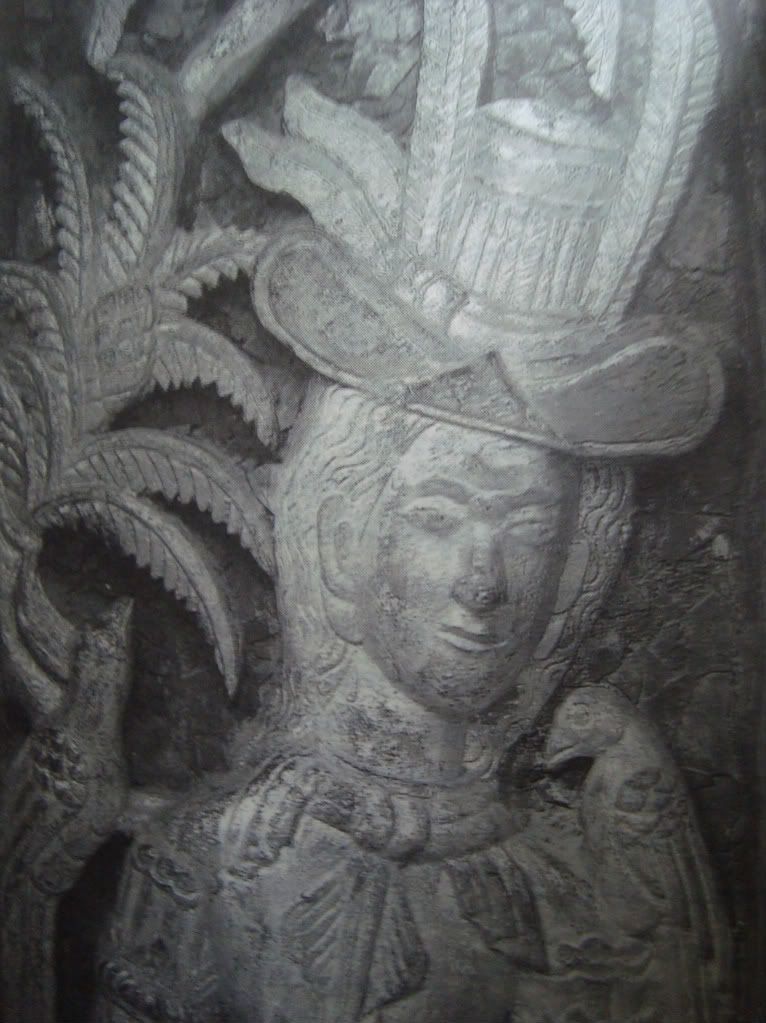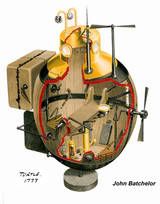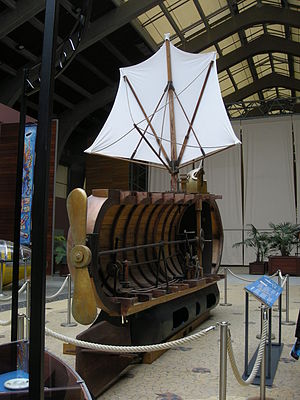
While doing research for an alternate history story set in Lan Xang, an interesting set of notes up regarding the possibilities of submarine technology such as the Nautilus of 20,000 Leagues Under The Sea.
Depending on how one wants to set up the development of technology in an alternate Southeast Asia, one can choose approaches that are wholly independent of Europe, limited interaction, or fully-engaged.
As we've mentioned before, the Dutch first reached Vientiane and the kingdom of Lan Xang in 1641.

What is interesting for this discussion is that in 1620, the first "practical" submarine was developed by a Dutch doctor named Cornelius Van Drebbel, who'd been living in England.

Van Drebbel's concept was a 12-man rowboat encased in greased leather, powered by rowers who pulled on oars that protruded through flexible leather seals connected to the hull. Van Drebbel's submarine crew was able to remain submerged for several hours at a time thanks to the use of snorkel air tubes that remained above the surface with floats. it was only capable of maneuvering approximately 12 to 15 feet below the river. King James I himself was said to have ridden in one. In history, this was repeatedly demonstrated with two other larger boats but considered of no interest to the British Navy. But it was a proven technology.
Van Drebbel was a inventor, physicist, and mechanician from Alkmaar, Holland who reputed to be a sorcerer because of the unusual inventions he developed over his lifetime. Besides the first navigable submarine, he has been credited with the development of a scarlet dye and a thermostat for a self regulating oven. Since the Dutch arrive in Lan Xang in 1641, it is not impossible that notes and details regarding Van Drebbel's concept could have been discussed between members of the king's court and the members of the expedition.
Historically, submarine designs will become very interesting, such as American David Bushnell's 1776 design for the Turtle submarine, which was propelled underwater by hand:
 Also of interest was the technology behind Robert Fulton's Nautilus, which had both a hand-crank and a sail for his submersible vessel in 1801 before he turned his attention to the steamboat. His nautilus could remain underwater for up to 5 hours. Fulton had designed the Nautilus for the French against the British Navy, and Napoleon had shown some interest in the matter.
Also of interest was the technology behind Robert Fulton's Nautilus, which had both a hand-crank and a sail for his submersible vessel in 1801 before he turned his attention to the steamboat. His nautilus could remain underwater for up to 5 hours. Fulton had designed the Nautilus for the French against the British Navy, and Napoleon had shown some interest in the matter.

Although the French ultimately turned him down, it was a workable design and it is possible in an alternate history timeline that had the French accepted the design and continued improvements, by the peak period for many steampunk stories, the British navy of the 1800s would be in a naval arms race to counter Fulton's devices.

For those of us addressing a Southeast Asian steampunk setting, this is a very key point where Franco-American technology could plausibly have reached the region. A big question would be, is the Vietnamese emperor Minh Mang's steamboat fleet in action, as well? Or perhaps another power's.
Bear in mind that it would be a significant challenge to make a working steam-powered submarine, given that you're talking about a fire-driven technology on boats made largely of wood and other combustible substances. If a nation has good access and skill at harnessing electricity, the use of a storage battery and electric motors would avoid the problems of carbon monoxide poisoning of the crews that internal combustion engines powered by fossil fuels could cause, among other hazards.
But the long and the short of it is, there are several interesting points in history where Southeast Asia could have had access to, and begun working with concepts of submersible boats and begun developing navies that incorporated them into their strategies. Admittedly, for Lan Xang, as a largely land-locked nation, there are some questions about how enthusiastically people would try to develop it.
It's uncertain who else would have found a use for them, except for perhaps explorers who wanted to peek beneath the rivers and lakes, despite fears of traditional creatures such as the nak and phi. Perhaps smugglers, but there seems little use for the devices among merchants and fishers? Or, like several technologies, would it reach the region and be regarded as merely a novelty?
But what other issues should be taken into account with submarine technology in Southeast Asia?

Van Drebbel's concept was a 12-man rowboat encased in greased leather, powered by rowers who pulled on oars that protruded through flexible leather seals connected to the hull. Van Drebbel's submarine crew was able to remain submerged for several hours at a time thanks to the use of snorkel air tubes that remained above the surface with floats. it was only capable of maneuvering approximately 12 to 15 feet below the river. King James I himself was said to have ridden in one. In history, this was repeatedly demonstrated with two other larger boats but considered of no interest to the British Navy. But it was a proven technology.
Van Drebbel was a inventor, physicist, and mechanician from Alkmaar, Holland who reputed to be a sorcerer because of the unusual inventions he developed over his lifetime. Besides the first navigable submarine, he has been credited with the development of a scarlet dye and a thermostat for a self regulating oven. Since the Dutch arrive in Lan Xang in 1641, it is not impossible that notes and details regarding Van Drebbel's concept could have been discussed between members of the king's court and the members of the expedition.
Historically, submarine designs will become very interesting, such as American David Bushnell's 1776 design for the Turtle submarine, which was propelled underwater by hand:


Although the French ultimately turned him down, it was a workable design and it is possible in an alternate history timeline that had the French accepted the design and continued improvements, by the peak period for many steampunk stories, the British navy of the 1800s would be in a naval arms race to counter Fulton's devices.

For those of us addressing a Southeast Asian steampunk setting, this is a very key point where Franco-American technology could plausibly have reached the region. A big question would be, is the Vietnamese emperor Minh Mang's steamboat fleet in action, as well? Or perhaps another power's.
Bear in mind that it would be a significant challenge to make a working steam-powered submarine, given that you're talking about a fire-driven technology on boats made largely of wood and other combustible substances. If a nation has good access and skill at harnessing electricity, the use of a storage battery and electric motors would avoid the problems of carbon monoxide poisoning of the crews that internal combustion engines powered by fossil fuels could cause, among other hazards.
But the long and the short of it is, there are several interesting points in history where Southeast Asia could have had access to, and begun working with concepts of submersible boats and begun developing navies that incorporated them into their strategies. Admittedly, for Lan Xang, as a largely land-locked nation, there are some questions about how enthusiastically people would try to develop it.
It's uncertain who else would have found a use for them, except for perhaps explorers who wanted to peek beneath the rivers and lakes, despite fears of traditional creatures such as the nak and phi. Perhaps smugglers, but there seems little use for the devices among merchants and fishers? Or, like several technologies, would it reach the region and be regarded as merely a novelty?
But what other issues should be taken into account with submarine technology in Southeast Asia?
No comments:
Post a Comment